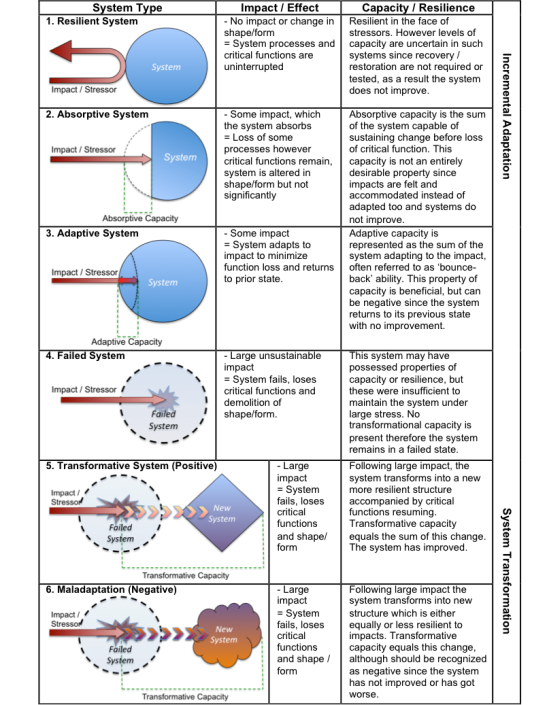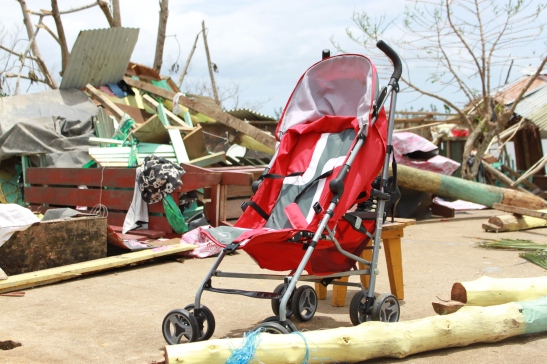Concept paper: a new systems approach to resilience
by Rory Walshe
Climate change adaptation has a problem. Its vocabulary consists of a huge number of intersecting and crosscutting concepts that are still under deliberation and academic debate. The application of these terms is problematic as it is, add to this their interaction with each other in any practical field based context and you have the potential for a very confusing situation.
In answer to this conundrum, this concept paper presents a new visualization of a systems approach to resilience.
By way of a starting point Climate Change Adaptation (CCA) in this paper is understood to be the adjustments in ecological, social or economic systems in response to actual or expected climatic stimuli, their effects or impacts (Smit et al. 2000). This can be further divided between incremental and transformational adaptation but I will leave that for another post.
To add to this complexity there has been a recent convergence in the academic dialog, where the commonalties between Climate Change Adaptation (CCA) and Disaster Risk Reduction (DRR) have been recognized (Mercer, 2010). It is at the confluence of these paradigms that we find our crosscutting concepts including: resilience, vulnerability, adaptation, absorption, transformation and capacity.
All of which can be integrated into a systems approach that holistically views the interactions, properties and processes of human, physical or natural systems in relation to climate change driven pressures.
A systems approach to resilience – and subsequently adaptation – has existed in many disciplines for some time; this includes economics (Arthur, 1999), organizations and institutions (Vogues & Sutcliffe, 2002; Wildavsky, 1991), ecological and social-ecological systems (Walker et al., 2004; Folke, 2006) as well as critical infrastructure (Bruneau, 2003; O’Rourke, 2007).
This systems approach has now emerged in CCA, partly in response to the concept of adaptation lacking the dimensions of time and place that are essential to understanding transformation, since adaptation is a dynamic process and not a static state (Cutter et al., 2000; Lewis & Kelman, 2010; Wisner et al., 2004). Concomitant with this emergence was an increased appreciation of the interconnected nature of systems and the goal of an integrated approach to systems modelling and management (Rockström et al., 2009).
A New Visualisation of a Systems Approach to Adaptation
The table below presents a new visualisation of a systems approach to adaptation, which illustrates properties of resilience when responding to climatic stressors. The red impact/stressor arrow represents environmental stressors. The systems can represent any scale or type of interconnected processes and actors, from global oceanic circulation systems to single rural households. The table encapsulates six different system types which each exhibit different properties. These are by no means exhaustive, the value of such a visualisation is to delineate between the various properties of resilience.

A new representation of a systems approach to resilience (© Rory Walshe and E Parker)
There are some important points that need to be stressed when using and examining this visualisation of system adaptation. Firstly, the processes involving the change or modification of a system can occur in absence of a physical disturbance to the system. Put simply a physical stressor is not a prerequisite for change; adaptation can represent anticipation in the form of an orchestrated preparedness strategy. Therefore the stressor/impact arrow also represents future predicted impacts of the climate change.
Secondly, system transformation to a more resilient shape can occur without form or function failure (systems five and six). This is not represented in a separate system in the diagram since experience has shown that systems very rarely display transformational properties without significant impact/stressors as a catalyst (Leiserowitz, 2004). This reflects the common difficulty of convincing stakeholders to undergo significant transformational change without the presence of physical stressors to justify such efforts (Kasperson et al., 2003).
Thirdly, it is necessary to recognize that this series of diagrams are a visualization of the various properties of systems that provide resilience and capacity (or lack of), with regards to adaptation. It is accepted that this is a simplistic and ultimately reductionist representation due to the diverse and inter-connected nature of such systems, which cannot be viewed in isolation from any number of external influences. Furthermore these properties are not mutually exclusive and can operate simultaneously on any one system.
Finally, there is a great deal of material, literature and investigation regarding these topics, which could not be detailed here due to its depth. Despite these disclaimers, the visualization is valuable in that it demonstrates the importance of considering the different system manifestations in adaptation interventions.
Perhaps the most compelling argument illustrated by this systems representation is that the more common incremental adaptation activities ultimately aspire to achieve properties similar to system one, a ‘resilient’ system, by instilling properties of absorption or adaptation. That most adaptation focuses on these ends has been remarked upon in various guises in the literature (Heazle et al., 2013; Kates et al., 2012; Nelson et al., 2007), there is also an extensive literature regarding maladaptation (see Barnett & Oneill, 2010). However, there is very little material that illuminates the major shortcoming of incremental adaptation, in that it fails to change or improve the system as a whole. Indeed most often adaptation simply increases the capacity of a flawed system to absorb or adapt to impacts as they occur, rather than transforming it into a more resilient form in pre-emption of a climatic stressor.
Kasperson et al. (1995) points out the danger associated with this approach in becoming consumed with the idea of solely ‘coping’ with system impacts rather than working to prevent or mitigate them in a larger transformational sense. Manyena (2006) builds upon this to suggest that the focus should be on building up system resilience as opposed to reducing system vulnerability. Ultimately, this is easier to achieve when taking a systems approach since it allows the total reformation of systems rather than simply piecemeal adaptation to reduce vulnerability.
This new visualisation also communicates the distinction between the three forms of change; absorption (system two), adaptation (system three), and transformation (system five & six), which are commonly neglected, confused or cited as equally important (Levina & Tirpak, 2006:22). This ‘catch-all’ terminology pitfall includes many other terms, including resilience, vulnerability, adaptation and capacity (ibid). It is important to differentiate between these properties because they are not equal or equally valuable. For example as shown the capacity provided by absorption provides less resilience compared to adaptation or transformation. This again stresses the importance of a systems approach since these nuances are often overlooked by adaptation as a product of a narrow focus.
Moreover, as a result of this narrow focus, is it more likely that adaptation strategies view systems (if they are even perceived as such), as closed and somehow external to other processes. This compartmentalization is often an inherent result of preoccupation with a specific focus of the stakeholder or actor involved, most commonly environmental, social (including political) or economic, which excludes the concerns and impacts on the sectors that are overlooked (Burton et al. 1993). As Folke et al. (2002) warns, this leads to a common oversight in categorizing human and natural systems as separate and therefore independently predictable and controllable.
Conversely system scale strategies strive to account for exogenous factors, which Pelling and Uitto (2001) suggest are essential in order to view local level impacts as outputs of increasingly global scale physical processes. This includes the impacts of climate change, but also political and economic processes, in order to prevent ignoring deeper root causes that may be distant in time and space from the manifestation of physical impacts (Cutter et al., 2000).
Furthermore, Oliver-smith (1999) points out that specific adaptations to single stressors tend to impose properties of resilience and adaptation on closed locations and timeframes, with the impacts and stressors representing only an isolated single catharsis. A transformative systems approach provides the more useful representation of such impacts as a culmination of a process protracted in time and space (Kaplan, 1999; Lewis & Kelman, 2010), which facilitates its effective mitigation.
Additionally, as Stafford-Smith et al. (2011) point out, climate change places a greater priority on longer term, more substantial and holistic adaptation activities. Such changes should not represent a single static future but rather a continuing transient process, which requires adaptation at a system level (Pittock & Jones, 2000).
Conclusion
In conclusion then, while there is certainly value in all types of adaptation, those which are not transformative can be compared to arranging the deckchairs on the Titanic; such efforts may have positive impacts in small scales, but it is ultimately futile against larger issues that are overlooked and neglected.
The actual solution must be more pragmatic, and will undoubtedly involve both and the many shades in-between. Critically, this adaptation cannot be left unsupervised in the hope of some naturally occurring Darwinian response, it will require sustained and systematized international effort, for there is a great deal at stake.
Endnote
This is the culmination of several years of mulling the concepts over in the back of my mind, ever since they were first introduced in Disaster Management classes in 2009 (thanks are owed to Dr. El Parker for planting this seed and first introducing the systems diagram concept). This was fed and developed while assessing post cyclone resilience in the South Pacific in 2013. Please bare in mind that this is a work in progress, constructive criticism is most welcome.
© Rory Walshe (r.walshe@uea.ac.uk)
Suggested citing:
Walshe, R., 2014. Concept paper: a new systems approach to resilience. [Online]. Available at: https://climate-exchange.org/2014/02/07/concept-paper-a-new-systems-approach-to-resilience [accessed + date when the website was accessed].


Pingback: The End of the Road? Can a Systems Approach to resilience be applied to roadway and transport systems in coastal cities and communities? | Climate Exchange